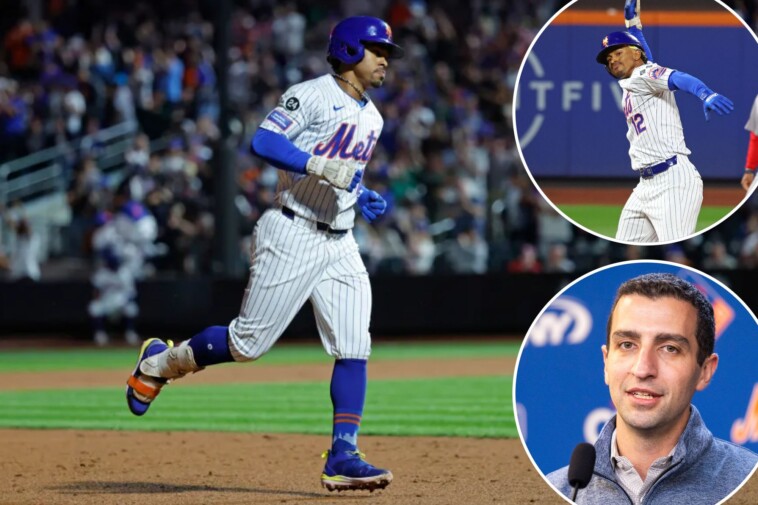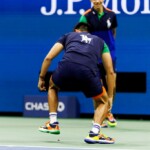Amid early NL MVP arguments, David Stearns believes Francisco Lindor’s season should not be merely compared with Shohei Ohtani’s.
How about 2024 Lindor vs. 2007 David Wright? Or 2006 Carlos Beltran? Or 1996 Bernard Gilkey? Or 1998 John Olerud?
In stumping for his star shortstop, Stearns aimed higher than Lindor surpassing all of his 2024 National League peers in value.
Maybe Lindor’s excellent season should be evaluated by whether he has taken down ghosts of the club’s past and might be authoring the greatest season ever for a Mets position player.
“We’re getting to the point, I think, where we’re talking about perhaps the greatest individual position-player season in the history of this franchise,” the Mets president of baseball operations — and a longtime Mets fan with a good knowledge of the history of the organization — said before the Mets played the Red Sox at Citi Field on Tuesday. “I’ve been around some really special seasons, been around some MVP seasons — this is right up there with anything I’ve seen on a day-to-day basis.”
Lindor’s back-of-the-baseball-card numbers are solid but not outstanding.
After going 2-for-4 with a home run, double, three RBIs and a steal, he owns a .273 average, .343 on-base percentage, .843 OPS with 30 home runs and 26 steals.
More extraordinary has been his steadiness, having never missed a game, and superb defense at a critical position.
His on-field contributions added up to 6.2 Wins Above Replacement, as judged by Baseball Reference, which entered play behind only Ohtani (7.1) in the National League. With about a month still to play to pad the total, Lindor’s 6.2 ranked as the 18th best in organization history.
The best Mets season, by this metric, belongs to Wright in 2007.
The third baseman was an All-Star, Gold Glover, Silver Slugger winner and finished fourth in MVP voting with a .325 average, .963 OPS, 30 homers, 107 RBIs and 34 steals.
Other contenders for the greatest-Mets-position-player-season crown include:
- Beltran in 2006, when the outfielder tallied 8.2 WAR with a monstrous offensive season (.982 OPS, 41 homers, 18 steals);
- Gilkey in 1996, when the left fielder exploded with 8.1 WAR, a .955 OPS, .317 average, 30 homers and 117 RBIs;
- Olerud in 1998, when the first baseman racked up 7.6 WAR behind a .354 average, .998 OPS, an outstanding .447 on-base percentage and 22 home runs;
- Lance Johnson in 1996, when the outfielder posted 7.2 WAR in his lone All-Star campaign with a .333 average, majors-best 21 triples, an .841 OPS and just 40 strikeouts in 160 games.
The Mets have seen plenty of special seasons, but they have never employed an MVP. Mike Piazza was hurt by a poor defensive reputation and the playing-time limitations of catchers before the advent of the NL DH, maxing out at 141 games in a season.
Three times a Met has placed second in MVP voting — Darryl Strawberry in 1988, Keith Hernandez in 1984 and Tom Seaver in 1969 — and perhaps Lindor will do what no Met has done before him.
Ohtani’s offensive numbers — entering play Tuesday with a .993 OPS, 44 home runs and 46 steals — dwarf Lindor’s (.835, 29 and 25, respectively). But voters will have to decide whether Lindor (or, say, the Diamondbacks’ Ketel Marte, the Reds’ Elly De La Cruz or the Phillies’ Bryce Harper) compensates enough by playing extraordinary defense while Ohtani, recovering from elbow surgery, strictly serves as DH. Another possible candidate, the Braves’ Marcell Ozuna, also does not play the field.
Those around the Mets will cite not just Lindor’s numbers or defensive prowess but the intangibles that have helped steady a team that could have wobbled off course.
It was Lindor who called the May 29, closed-door team meeting that ushered in a level of accountability for a club that had fallen 11 games under .500.
“I think that’s part of the entire package that he brings,” said Stearns, who watched Christian Yelich win NL MVP with his Brewers in 2018. “It’s easy to quantify what he does on the field, and that’s really impressive. [It is] much harder to quantify the impact he has both on what he says and also by how he acts.
“He works so hard, he takes so much pride in his own preparation, but also ensuring his teammates prepare appropriately. It’s the entire package that I think allows him to contribute so much to the organization.”
Stearns — a person essentially tasked with finding value for his team — was asked what the Most Valuable Player looked like to him.
“I think he looks like the guy who runs out to shortstop at 7:00,” Stearns said.







